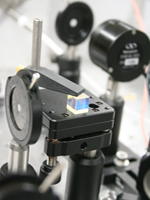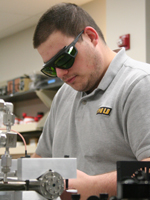 |
 |
 |
| Points of Contact: | Oleksandr Kokhan |
Lasers are an essential part of our modern society. They are components of home electronics, manufacturing equipment, surgical procedures, atmospheric monitoring devices, and also are a key piece of technology for chemical research. Lasers have transformed modern chemistry. Currently, chemists are able to use lasers to initiate, control, and watch chemical reactions on a scale that was unimaginable 50 years ago. James Madison University has a large laser spectroscopy laboratory that distinguishes it from other primarily undergraduate institutions. Researchers are able to utilize the Facility’s holdings to perform an abundance of interdisciplinary scientific research.
The JMU Regional Undergraduate Laser Facility has grown through many years of support from multiple funding agencies (National Science Foundation, National Institute of Standards and Technology, National Institute of Health, Jeffress Trust, the James Madison University Department of Chemistry and Biochemistry, and a Research Corporation Department Development Award). Holdings include multiple Nd/YAG, nitrogen, helium/neon, argon ion, and diode lasers. The facility is also equipped with an array of diagnostic tools for laser spectroscopy including a wide range of digital oscilloscopes, monochromators, diode array detectors, signal and delay generators.
The Facility has a particularly reach collection of pulsed lasers used for time-resolved absorbance and fluorescence experiments. In last few years we acquired a Coherent Mira-900 femtosecond laser with a new (2023) Coherent Verdi C12 pump laser; a high-power frequency-tripled Continuum Nd/YAG laser with Optical Parametric Oscillator, which can be tuned in the range from 410 to 2200 nm; a supercontinuum laser (Leukos – SCM-8, <1 ns pulse width, 8kHz, 350-2200 nm spectral bandwidth). Our other recent acquisitions include: two optical tables with pneumatic vibration isolation, an ARS closed cycle optical cryostat for 4-355K temperature range, multiple fiberoptic CCD spectrophotometers, cameras, power meters, oscilloscopes and signal generators.
